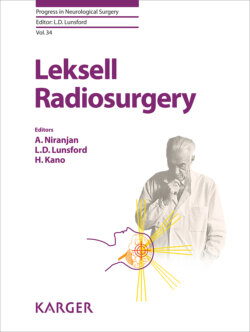Читать книгу Leksell Radiosurgery - Группа авторов - Страница 12
На сайте Литреса книга снята с продажи.
X-Rays and Protons
ОглавлениеAfter some unsuccessful experiments using ultrasound, in 1951 Leksell published his seminal paper describing in theory how SRS could be accomplished [4]. In 1953 Leksell put his theory into practice by treating 2 patients with trigeminal neuralgia with SRS (Fig. 3). The arc of the stereotactic instrument was attached to an orthovoltage X-ray tube. In this fashion the beam could slide right and left along the arc and the arc itself could be tilted forward and backward. Thus, multiple beams came to bear on the gasserian ganglion from different directions.
Fig. 3. 1950 – the first 2 patients treated by connecting the stereotactic arc to an orthovoltage X-ray tube.
The energy of the X-ray tube was too low, at 280 kV, which made the procedure long and tedious. The setup with the arc carrying the weight of the X-ray tube was also problematic. Nevertheless, both patients were pain free after a few months, and remained pain free at 17 years. The result warranted more work and the search for a better source of radiation was on.
In the late 1950s Leksell made contact with Börje Larsson, a radiobiologist and physicist who was to become head of the Gustav Werner synchrocyclotron laboratory in Uppsala, an hour north of Stockholm. Leksell was then chairman of neurosurgery in Lund. Together they started a systematic look into the future possibilities of Leksell’s non-invasive alternative to open brain surgery. A much sturdier version of the Leksell frame was manufactured to combine with the gantry of the cyclotron. The center-of-arc principle remained the same, with the arc rotating around the beam exit point. A series of animal experiments were undertaken to better understand the effects of single-dose radiation to the brain and the dose necessary to achieve a lesion [5–7]. Finally, in 1961, the first patients were treated in Uppsala (Fig. 4).
Fig. 4. 1961 – the first patient treated with the synchrocyclotron in Uppsala.
The cross-fired proton beam was good but Leksell found the cyclotron impractical for clinical use. I remember how the heavy frame was attached to the patient’s head in Stockholm and how we drove the 70 km to Uppsala with the patient sitting in the back seat of our private car. One cannot help but wonder what people in overtaking cars were thinking when they saw the patients with this contraption on their head!
The next step in the search for a suitable beam was to use an existing linear accelerator at the Karolinska Hospital in stereotactic conditions (Fig. 5). A small series of patients with arteriovenous malformations (AVMs) were treated in this fashion but the results in terms of obliteration were not satisfactory. In parallel, Larsson and Leksell had begun working on the specifications for what would later become the first prototype GK (Fig. 6) [8].
Fig. 5. The linear accelerator used in stereotactic conditions for AVMs. Not good enough at the time.
Fig. 6. 1963 – the summary specifications for what was to become the GK in 1967.
